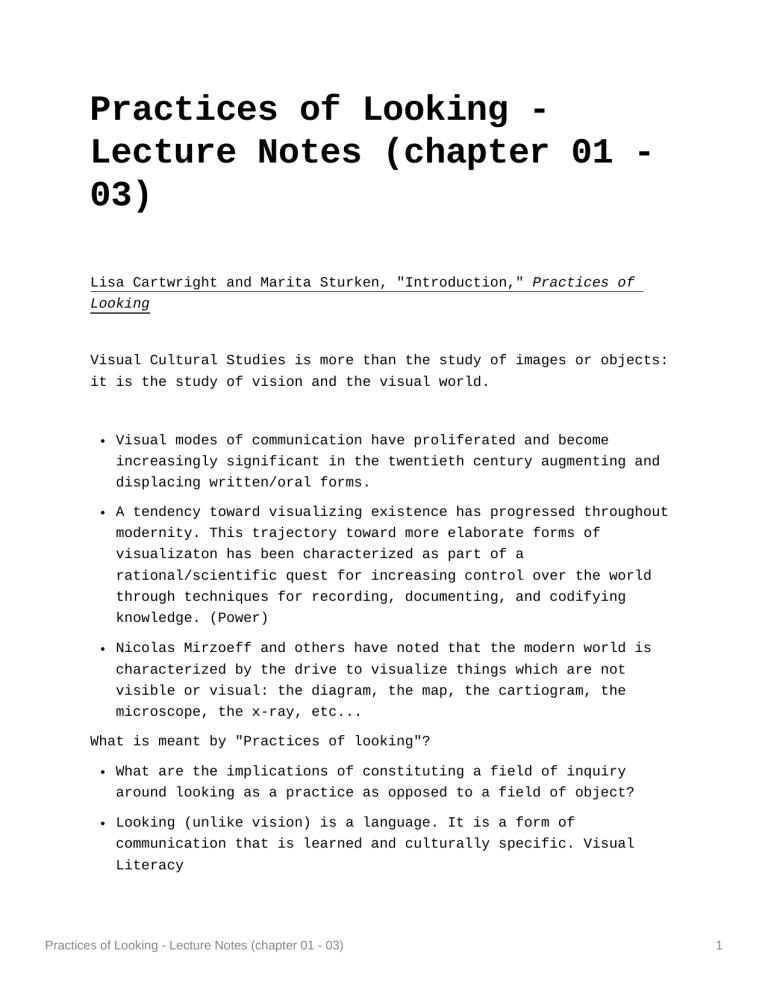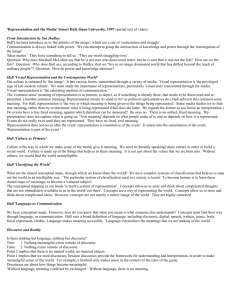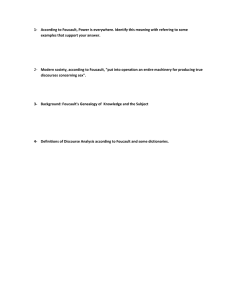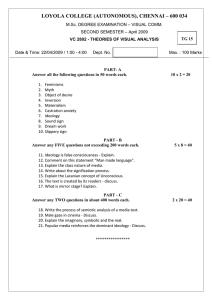
Practices of Looking Lecture Notes (chapter 01 03) Lisa Cartwright and Marita Sturken, "Introduction," Practices of Looking Visual Cultural Studies is more than the study of images or objects: it is the study of vision and the visual world. Visual modes of communication have proliferated and become increasingly significant in the twentieth century augmenting and displacing written/oral forms. A tendency toward visualizing existence has progressed throughout modernity. This trajectory toward more elaborate forms of visualizaton has been characterized as part of a rational/scientific quest for increasing control over the world through techniques for recording, documenting, and codifying knowledge. (Power) Nicolas Mirzoeff and others have noted that the modern world is characterized by the drive to visualize things which are not visible or visual: the diagram, the map, the cartiogram, the microscope, the x-ray, etc... What is meant by "Practices of looking"? What are the implications of constituting a field of inquiry around looking as a practice as opposed to a field of object? Looking (unlike vision) is a language. It is a form of communication that is learned and culturally specific. Visual Literacy Practices of Looking - Lecture Notes (chapter 01 - 03) 1 Intertextuality: Is it possible to study diverse forms of visual culture together? And is it useful? Meaning isn't confined to one discipline: scientific images are interpreted based on experiences in popular film and popular culture. Practices of looking can be bridges between specialized discourses Memory has a strong role in visual experience. We understand a visual image within a stream or network of other images and experiences--relationally Images are understoood historically Meaning and Culture: Raymond Williams: Culture is a set of shared practices for making meaning. The anthropological definition of culture as a "way of life". Seeing and believing--the relationship of seeing to belief systems. "Meaning is shared, but not uniformly." There are always multiple potential meanings for an image or text. The same text or image suggests different meanings for different viewers or for the same viewer at different times. How can we explain this? What factors affect interpretation? Meaning is contextual. Making meaning is an active process--it is not purely a matter of perception or reception. Meanings are produced not in the heads of viewers so much as through a process of negotiation--the play of interpretations. Culture is a fluid and interactive process--not a set of images or objects. "Chapter 1: Image, Power and Politics," Practices of Looking Practices of Looking - Lecture Notes (chapter 01 - 03) 2 Looking is active. Looking involves relationships of power Meaning is imbedded in social relations, not in objects themselves. Weegee (Athur Fellig) "Booking a Suspect," (1937), "Their First Murder" (1936) and "Hells Kitchen". Looking at others looking. How does the image capture or convey emotion. Voyerism and the power of looking without being seen. Pietrer Claesz (Dutch), Still Life with Herring, Breakfast, Still Life with Herring, Wine, and Bread, Vanitas Still Life 1630)-objects that symbolized the vanity of worldly things and the brevity of life. The skull and bones refer to death, books and writing instruments to excessive pride through learning, and fragile glass goblet of wine to temporary pleasure. The golden cup on its side suggests immoderate wealth. Reflective obects often included distorted images of the artist. Images are embedded in subjective relations We live in an age of reproduction: knowledge of most images is not first-hand. We encounter millions of objects which are not unique. Documentary and "photographic truth" Photograph's "aura of machine objectivity" Do all images created through a camera lens involve some form/degree of subjective intervention? Is there a truly objective or non-subjective photography? Are some photographs more truthful? What can we say of painterly truth or the truth of writing? What is a document? A record? The coincidence of the historical record and the emotional vehicle: Robert Frank: The Americans Trolley, New Orleans (1958)(comparison) Practices of Looking - Lecture Notes (chapter 01 - 03) 3 Robert Frank: Charleston, South Carolina (Photo of a black woman holding a white baby) Woman on a BusBenetton ad with a woman nursing a baby What photographic film records is a segment of the field of vision depth of field range of light intensity and color fstop and exposure cropping bracketed moments in time temporality film stock--technology is a factor in the creation of meanings-technologies are cultural formations. Consider film density test patterns. (example 1; example 2;) Joseph Albers' Color theory Exercises: http://www.marilynfenn.com/color_study.html Images and Icons: Certain images become iconic (they become a type)--they carry an influential interpretive weight Iconic images are those that becomes symbolic and suggest a universal meaning. But all icons can be read for their particular historical meanings. The iconic image of the Madonna and child may affect our reading of contemporary images. Rahael, The Small Cowper Modanna (c 1505), Joos van Cleve, Virgin and Child (1515), Dorethea Lange, "Migrant Mother" (1936) #1, #2, #3, #4, #5, Benneton Advertisement woman with baby Marilyn Monro, Andy Warhol, Marilyn Dyptich(1962) Madonna (and "with child") Finally, one could argue that all images have an iconic register. Value, Taste and Economies of Images: Practices of Looking - Lecture Notes (chapter 01 - 03) 4 While the fine art object often is valued because it is unique, it also can be valued because it can be reproduced for popular consumption. Museums and institutions such as universities affirm value. Example: Van Gogh, Irises (1889) Irises (1888)(poster of the painting, costers, jar). Value and taste as a product of history, rarification, the interplay of interpretive, legal and economic factors. For example, the laws surrounding the establishment of museums as tax exempt institutions. Or the policies regarding rights to publicity, copyright and privacy. (industry, mobility, color and images of the landscape) Komar and Melamid's "Most Wanted Paintings" How do popular and expert tastes or preferences relate to economic value of cultural artifacts? In what ways does meaning relate to value? "Chapter 2: Viewers Make Meaning," Practices of Looking “The production of meaning involves… 1. The codes and conventions that structure the image and that cannot be separated from the content of the image; 2. the viewers and how they interpret or experience the image; 3. the contexts in which an image is exhibited and viewed. (49) Viewer =/= audience interpellation: derived from the Marxist philosophy of Louis Althusser, to be interpellated is to be called out to by an ideology. “To be interpellated by an image… is to know that the image is meant for me to understand, even if I feel that my understanding is unique or goes against the grain of a meaning that seems to have been intended” (50) http://www.marxists.org/reference/archive/althusser/1970/ideology.htm Practices of Looking - Lecture Notes (chapter 01 - 03) 5 advertising identification Producers’ Intended Meanings Who creates an image? Death of the Author, by Roland Barthes http://evans-experientialism.freewebspace.com/barthes06.htm What Is An Author, by Michel Foucault http://www.generation-online.org/p/fp_foucault12.htm Authorial intent is suspect. Barthes says “the text offers a multidimensional space that the reader deciphers or interprets” (52). Not that the producers of images don’t have a preferred meaning, but Barthes and Foucault suggest that the context in which the image is read can never fully be controlled or predicted. This is an even bigger deal in global intercultural contexts. Aesthetics and Taste How do you judge an image? This section discusses taste. Pierre Bordieu: French sociologist who wrote that taste is always connected to social identity, and contains a certain kind of “cultural capital”. Quoting Bordieu: “Taste classifies, and it classifies the classifier. Social subjects, classified by their classifications, distinguish themselves by the distinctions they make, between the beautiful and the ugly, the distinguished and the vulgar, in which their position in the objective classifications is expressed or betrayed.” (60) habitus: a term from Bordieu meaning “a set of dispositions and preferences we share as social subjects that are related to our class Practices of Looking - Lecture Notes (chapter 01 - 03) 6 position, education, and social standing” (60) high and low culture: traditionally used to distinguish between elite culture that only the rich/upper class can appreciate and vulgar culture for the masses. This distinction has been widely critiqued as condescending. (444) Collecting, Display, and Institutional Critique Collecting and power http://www9.georgetown.edu/faculty/irvinem/theory/CliffordOnCollectingArtandCulture.pdf Institutional critique: from Foucault, institutions have acted as invisible structures of power that produce certain kinds of knowledge and bodies. When artists do institutional critique, they intervene in the structure of the museum and exhibit itself to discuss how Practices of Looking - Lecture Notes (chapter 01 - 03) 7 museums structure the kinds of meanings that are made about art and artifacts. Reading Images as Ideological Subjects According to Marx, the people who own the means of production in a society also control that society’s media and the kinds of things that are and can be said in it. They reproduce the dominant ideology, which he thought was a kind of false consciousness, and in order to critique anything you have to reject that falsity. Althusser said that “ideology represents the imaginary relationship of individuals to the real conditions of existence” (69). According to him, ideology isn’t false–it’s all we have to make sense of the world. You can’t get outside of ideology. You become a subject by being hailed by ideology. This doesn’t give individual subjects a lot of agency to resist or move around. Antonio Gramsci, another Marxist, wrote about hegemony as an alternative theory to domination. Under hegemony, power is negotiated among many different competing groups. The “dominant culture” is created through struggle. Nobody simply has power, and the situation is constantly in flux. Ideology can be contested and undermined (through “counter-hegemonic” activity). But because of this flux, hegemony has to be constantly be reasserted. http://www.marxists.org/archive/gramsci/index.htm Encoding and Decoding Stuart Hall: in “Encoding, Decoding”, Hall writes about three different ways of reading a cultural text. http://www9.georgetown.edu/faculty/irvinem/theory/SH-Coding.pdf 1. Dominant-hegemonic reading: reading it the way society wants you to Practices of Looking - Lecture Notes (chapter 01 - 03) 8 2. Negotiated reading: somewhere between 1 and 3, both gets pleasure from a hegemonic text and “poaches” on it 3. Oppositional reading: reading in a totally opposite way to what culture wants you to (separatist, possibly radical) Reception and the Audience Reception theory: the viewer response to popular texts De Certeau’s The Practice of Everyday Life textual poaching: “inhabiting” a text and taking it up in ways that are counter to authors’ intents strategies vs. tactics: De Certeau wrote about strategies, which are culturally authorized ways of making meaning, and tactics, which are unauthorized and part of radical organizing transcoding: the re-appropriation of formerly derogatory words for new social meanings (queer, crip, “Black is beautiful) Bricolage: Claude Levi-Strauss, “making do”, putting this to use for unintended but productive purposes Appropriation and Cultural Production Particularly in the digital era, the appropriation and reworking of elements of visual culture is easy and prevalent. Reappropriation and Counter-Bricolage Sometimes culture is re-appropriated by marketers or corporate entities and used for non-political purposes. "Chapter 3: Spectatorship, Power, Knowledge" Practices of Looking Key Terms Spectator: the individual who looks Spectatorship: the practice of looking The gaze: the relational activity of looking (Las Meninas) Practices of Looking - Lecture Notes (chapter 01 - 03) 9 Interpellation: process of interpretation through which an individual viewer comes to recognize himself or herself as among the class or group of subjects for whom the image’s message is intended. Discourse: group of statements that provide a means for talking about a particular topic at a particular historical moment; a body of knowledge that both defines and limits what can be said about something Biopower: the relationships of power that are exercised indirectly on and through the body Identification: process in which the spectator responds to an image (as object of desire or view self in place of the person on canvas/ screen) The Subject in Modernity Key Contributors: Sigmund Freud: the subject is governed by the unconscious Karl Marx: argues we are produced as human subjects by the forces of labor and capitalism Michel Foucault: subject is created through discourses of institutional life Jacques Lacan: subject never really existed, but rather is an ideal that results from the mirror phase of human development: subject (the infant) becomes aware of itself in relation to what it is not (the mother) => the ego is split from the very beginning Spectatorship The gaze and spectatorship as concepts in visual studies allow us to consider: 1. the roles of the unconscious and desire in viewing practices (Freud) Practices of Looking - Lecture Notes (chapter 01 - 03) 10 2. the role of looking in the formation of the human subject as such (Lacan) 3. the ways that looking is always a relational activity and not simply a mental activity engaged in by someone who forms internal mental representations that stand for a passive image object “out there” (Marx, Foucault); (102). The gaze and spectatorship are theories of address, not of reception: Address considers the ways that an image or visual text invites certain responses from a particular category of viewer (i.e., the male or female viewer) Discourse and Power Foucault: discourses produce certain kinds of subjects and knowledge and that we occupy to varying degrees the subject positions defined within a broad array of discourses Photography a factor in social discourses: photographs used for surveillance, regulation, categorization Photographs used to establish difference; that which is defined as other is posited as that which is not the norm or the primary subject Foucault’s panopticon: demonstrates the power of the imagined spectator; leads to practices of self-regulation The camera is the visible presence of the inspecting gaze that we imagine Foucault argues modern societies use power structures to produce self-regulating citizens Power relations establish the criteria for what gets to count as knowledge in a given society, and knowledge systems in turn produce power relations Photographic images produces ideas of the ideal look or body Practices of Looking - Lecture Notes (chapter 01 - 03) 11 The Gaze and the Other The act of looking commonly regarded as awarding more power to the one looking rather than the one being looked at Derrida: argues all binary oppositions (which the photograph tends to encourage) encoded with values, and these oppositions often overlap and are not mutually exclusive The gaze encourages a self (or me)/ other binary =>Exotic Other: La Grande Odalisque The exotic other (usually operates on binary opposition between West and East) (La Grande Odalisque) The Gaze in Psychoanalysis Cinematic apparatus (the traditional social space of the dark theater) encourages viewers to suspend disbelief and identify with characters in the film and the film’s ideology Cinematic apparatus (the traditional social space of the dark theater) encourages viewers to suspend disbelief and identify with characters in the film and the film’s ideology Female nude often understood as the project and possession of the male artist (Venus and Cupid) “men act, women appear” (John Berger) the woman typically gazes at herself or outward at the viewer who meets her look Laura Mulvey: camera used as a tool to disempower those before its look Cinema geared toward male viewing pleasure, with women positioned as objects of the gaze Practices of Looking - Lecture Notes (chapter 01 - 03) 12


